Introduction to Sun Conure Talking
Sun Conures, with their vibrant plumage and playful demeanor, are beloved companions for many bird enthusiasts. One of the fascinating aspects of these charismatic birds is their ability to communicate through vocalizations. In this article, we delve into the intricacies of Sun Conure talking, exploring their communicative nature, talking abilities, species variations, training techniques, recent research insights, and the role of technology in enhancing their communication skills.
Understanding the Communicative Nature of Sun Conures
Sun Conures are highly social birds known for their expressive vocalizations. They use a variety of sounds to communicate with their flock members and human companions. Understanding the underlying motives behind their vocalizations is crucial for effective communication.

Importance of Communication in Sun Conures
Communication plays a vital role in the life of a Sun Conure. It helps them express their needs, emotions, and establish social bonds within their community. Effective communication contributes to their overall well-being and strengthens the bond between the bird and its owner.
Sun Conure Talking Abilities
Natural Vocalizations: Exploring the Melodic Repertoire
Sun Conures possess a diverse range of natural vocalizations, including squawks, chirps, and screams. These sounds serve various purposes, from expressing happiness and excitement to signaling danger or distress.
Mimicry Mastery: Unveiling Their Imitative Skills
One of the most remarkable abilities of Sun Conures is their talent for mimicry. They can mimic human speech, environmental sounds, and even other bird calls with astonishing accuracy.
Contextual Communication: Deciphering the Meaning Behind Sounds
While Sun Conures excel in mimicry, they also exhibit contextual communication. They modulate their vocalizations based on the situation, conveying nuanced messages through tone, pitch, and rhythm.
Sun Conure Species Known for Talking
Notable Sun Conure Varieties with Exceptional Talking Abilities
Certain Sun Conure species, such as the Jenday and the Cherry-headed Conure, are renowned for their exceptional talking abilities. When selecting a talking Sun Conure as a pet, consider the species known for their proficiency in mimicry and communication.

Choosing the Right Talking Sun Conure as a Pet
When choosing a talking Sun Conure, it’s essential to consider factors such as temperament, individual personality, and previous training history. A well-socialized bird with a penchant for vocalization can make an excellent talking companion.
Techniques for Enhancing Sun Conure Talking
Old Techniques: Preserving Traditional Methods
Mirror Training: Using Mirrors to Encourage Mimicry and Vocalization
Mirror training involves placing mirrors within the Sun Conure’s environment to stimulate vocalization by providing visual feedback. When a Sun Conure sees its reflection, it may perceive it as another bird and attempt to communicate with it through vocalizations. Over time, this can encourage the bird to mimic sounds and develop its vocal repertoire.
For example, by placing a small mirror near the bird’s perch, owners can observe their Sun Conure’s response and adjust the placement to encourage interaction.

Classical Conditioning: Associating Words with Rewards
Classical conditioning involves associating words or phrases with positive reinforcements, such as treats or praise, to encourage Sun Conures to vocalize specific sounds. By consistently rewarding desired vocalizations with treats or affection, owners can reinforce the association between words and rewards, motivating the bird to repeat the behavior. For instance, when a Sun Conure successfully mimics a word or phrase, the owner can immediately reward it with a favorite treat, reinforcing the desired behavior and encouraging further vocalization.
Whistle Training: Introducing Whistles as Signals
Whistle training involves teaching Sun Conures to associate specific whistles with desired behaviors or commands, encouraging them to vocalize in response to auditory cues. By consistently using a particular whistle pattern in conjunction with a desired action or behavior, owners can train their Sun Conures to recognize and respond to the whistle signal.
For example, by using a short, distinct whistle as a signal for mealtime, owners can prompt their Sun Conure to vocalize in anticipation of food, reinforcing the association between the whistle and the desired behavior.
Recent Techniques: Embracing Innovative Approaches
Target Training: Associating Sounds with Objects or Actions
Target training involves teaching Sun Conures to respond to specific targets or cues, such as colored objects or designated areas, by vocalizing or performing a behavior. By associating verbal cues with specific objects or actions, owners can encourage their Sun Conures to vocalize in response to visual stimuli.
For example, by introducing a brightly colored target and using a verbal cue such as “touch” or “say hello,” owners can prompt their Sun Conure to vocalize while interacting with the target, reinforcing the association between the verbal cue and the desired behavior.
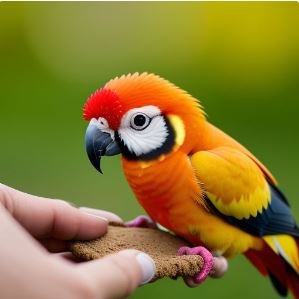
Social Learning: Learning from Peers
Social learning involves exposing Sun Conures to other talking birds or human companions to facilitate mimicry and language acquisition. By providing opportunities for interaction with vocal role models, such as experienced talking birds or humans, owners can encourage their Sun Conures to mimic sounds and learn new vocalizations.
For example, by placing their Sun Conure in the presence of a talking parrot companion or regularly interacting with the bird themselves, owners can provide social cues and reinforcement that promote vocalization and language learning.
Audio Recording Playback: Stimulating Imitation
Audio recording playback involves playing recorded human speech or bird vocalizations to stimulate mimicry and encourage Sun Conures to expand their vocal repertoire. By exposing Sun Conures to a variety of sounds and vocalizations, owners can inspire them to imitate and learn new sounds.
For example, by playing recordings of common phrases or words repeatedly in the Sun Conure’s environment, owners can create opportunities for the bird to practice mimicry and develop its vocal abilities.
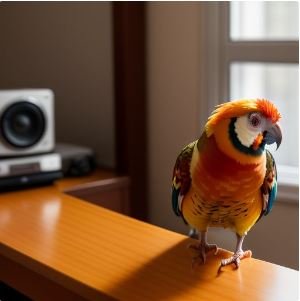
Modern Techniques: Harnessing Technological Advancements
Clicker Training: Marking Desired Vocalizations
Clicker training involves using a small handheld device that emits a distinct clicking sound as a marker to signal desired behaviors or vocalizations in Sun Conures. By pairing the clicker sound with specific vocalizations, owners can effectively communicate to their birds when they’ve produced the desired sound.
For example, when the Sun Conure successfully mimics a word or makes a desired vocalization, the owner immediately activates the clicker, indicating to the bird that it has performed the behavior correctly. This reinforcement strengthens the association between the vocalization and the positive outcome, encouraging the bird to repeat the behavior in the future.
Video Modeling: Learning through Audiovisual Stimuli
Video modeling involves exposing Sun Conures to videos or audiovisual stimuli featuring talking birds or human speech to encourage mimicry and language learning. By providing visual and auditory cues, owners can stimulate the Sun Conure’s interest and motivation to imitate sounds and expand its vocal repertoire.
For example, owners can play videos of talking birds or human speech on a screen within the bird’s environment, allowing the Sun Conure to observe and mimic the vocalizations it hears. This immersive learning experience can enhance the bird’s ability to learn new sounds and improve its communication skills.
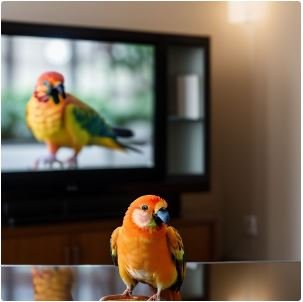
Speech Recognition Apps: Providing Interactive Feedback
Speech recognition apps utilize advanced technology to analyze and interpret Sun Conure vocalizations, providing interactive feedback and assistance in training. By using smartphones or tablets equipped with speech recognition software, owners can accurately identify and analyze the bird’s vocalizations in real time.
For example, owners can use speech recognition apps to record their Sun Conure’s vocalizations and receive instant feedback on the accuracy and clarity of the sounds produced. This feedback enables owners to adjust their training techniques accordingly and tailor their approach to the individual needs of their bird, facilitating more effective communication and language learning.
Recent Research Insights on Sun Conure Talking
Scientific Studies: Exploring Cognitive Mechanisms
Recent scientific studies have shed light on the cognitive mechanisms underlying Sun Conure communication, revealing insights into their learning abilities and language processing skills.
Emerging Trends: Innovations in Communication Research
Advancements in communication research have led to innovative techniques and methodologies for studying Sun Conure vocalizations, offering new avenues for understanding their communication patterns.
Harnessing Technology for Sun Conure Talking
Artificial Intelligence Assistance: Personalized Training Programs
Artificial intelligence (AI) assistance leverages algorithms to develop personalized training programs tailored to the unique needs of individual Sun Conures. These programs utilize machine learning techniques to analyze the bird’s vocalizations and behavior patterns, identifying areas for improvement and adapting the training approach accordingly.
For example, AI-powered training programs can track the Sun Conure’s progress in vocalization training and adjust the difficulty level of exercises or provide targeted feedback based on the bird’s performance. This personalized approach maximizes the effectiveness of training efforts and accelerates the bird’s language learning process.
Voice Modulation Software: Customizing Vocalizations
Voice modulation software allows owners to modify and enhance Sun Conure vocalizations, enabling customization of the bird’s communication abilities. These software tools offer features such as pitch adjustment, tone modulation, and sound effects to alter the characteristics of the bird’s vocalizations.
For example, owners can use voice modulation software to refine the clarity and pronunciation of specific words or phrases that their Sun Conure is learning to mimic. By fine-tuning the bird’s vocalizations, owners can improve its communication skills and ensure accurate replication of desired sounds.
Virtual Reality Environments: Immersive Training Platforms
Virtual reality environments provide immersive platforms for simulated communication scenarios and training sessions with Sun Conures. These environments offer interactive experiences that engage the bird’s senses and encourage active participation in language learning activities.
For example, owners can use virtual reality headsets to create simulated environments where their Sun Conures interact with virtual objects or avatars representing human speech models. By exposing the bird to realistic communication scenarios in a controlled virtual environment, owners can facilitate language acquisition and reinforce desired vocalizations in a fun and engaging way.

Telecommunication Devices: Remote Interaction
Telecommunication devices enable remote communication with Sun Conures, facilitating long-distance training and interaction between owners and their birds. These devices utilize video calls, voice-enabled applications, or specialized communication tools to connect owners with their Sun Conures from anywhere in the world.
For example, owners can use video calling applications on their smartphones or computers to interact with their Sun Conures while away from home. By engaging in real-time communication and training sessions remotely, owners can maintain continuity in their training efforts and strengthen the bond with their birds, regardless of their physical location.
Understanding Sun Conure Vocalization Patterns
Daily Vocal Routines: Observing Regular Patterns
Sun Conures have distinct vocal routines that vary throughout the day, from morning chatter to evening calls. Observing these patterns can provide insights into their communication needs and preferences.
Emotional Expressions: Decoding Vocalizations
Sun Conures use vocalizations to express a wide range of emotions, including joy, fear, and affection. Understanding the emotional context behind their vocalizations is key to interpreting their messages accurately.
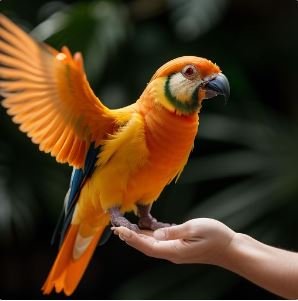
Overcoming Challenges in Sun Conure Talking Training
Patience and Persistence: Essential Virtues
Training Sun Conures to talk requires patience, consistency, and persistence. It’s essential to remain dedicated and encouraging throughout the learning process, even in the face of challenges.
Troubleshooting Common Issues
Common challenges in Sun Conure talking training include reluctance to vocalize, limited vocabulary, and inconsistency in mimicry. By addressing these issues with patience and creativity, progress can be achieved.
Fostering a Talking Environment for Sun Conures
Optimal Living Conditions: Creating a Stimulating Environment
Providing Sun Conures with a stimulating environment enriched with toys, perches, and social interaction can foster communication and language development.
Socialization Strategies: Encouraging Interaction
Encouraging interaction with other birds, humans, and environmental stimuli can promote socialization and language learning in Sun Conures.
Incorporating Verbal Cues in Sun Conure Talking
Basic Commands: Building Foundations
Introducing Sun Conures to basic commands, such as “hello” or “goodbye,” lays the foundation for further speech development and communication.
Advanced Training Techniques: Expanding Vocabulary
Gradually introducing new words and phrases expands the Sun Conure’s vocabulary and increases their linguistic repertoire.
Assessing Sun Conure Talking Progress
Monitoring Vocal Development: Tracking Milestones
Regularly monitoring Sun Conure’s vocal development and noting milestones can help gauge progress and identify areas for improvement.
Adjusting Training Strategies: Adapting to Individual Needs
Flexibility in training approaches allows for customization based on the individual needs and learning style of each Sun Conure.
Engaging Sun Conure Talking Activities
Interactive Games: Making Learning Fun
Incorporating interactive games and activities into language training sessions makes learning enjoyable and reinforces verbal cues.
Enrichment Exercises: Stimulating Mental Agility
Engaging Sun Conures in enrichment exercises, such as puzzle toys or foraging activities, stimulates mental agility and encourages language development.
Sun Conure Talking and Human Bonding
Strengthening the Human-Parrot Connection
Effective communication fosters a strong bond between Sun Conures and their human companions, enriching their relationship and mutual understanding.
Shared Experiences: Building Trust
Engaging in dialogue and shared experiences strengthens trust and rapport between Sun Conures and their owners, deepening the bond of companionship.
Conclusion: Unlocking Potential of Sun Conure Talking
In conclusion, Sun Conures possess remarkable communication skills that can be enhanced through understanding, training, and technological support. By embracing innovative techniques and fostering a supportive environment, owners can unlock the full potential of Sun Conure talking, enriching the lives of both birds and humans alike.
FAQs: Clarifying Common Queries About Sun Conure Talking
How Long Does It Take to Teach a Sun Conure to Talk?
The time it takes to teach a Sun Conure to talk varies depending on factors such as individual temperament, previous training, and consistency in training efforts. With patience and persistence, most Sun Conures can learn to mimic human speech to some extent.
Can All Sun Conure Species Learn to Talk Equally Well?
While all Sun Conure species have the potential to learn to talk, certain varieties, such as the Jenday and Cherry-headed Conures, are known for their exceptional talking abilities. When selecting a Sun Conure talking as a pet, consider the species reputed for their proficiency in mimicry and communication.
What Are Some Tips for Encouraging Vocalization in Sun Conures?
To encourage for Sun Conures talking, provide a stimulating environment, engage in regular interaction, and use positive reinforcement techniques such as treats or praise. Consistent training efforts and exposure to verbal cues can also promote speech development.
Are There Risks Associated with Teaching Sun Conures to Talk?
While teaching Sun Conures to talk can be a rewarding experience, it’s essential to be mindful of potential risks, such as frustration or stress if the bird struggles with mimicry. Avoid excessive pressure and prioritize the bird’s comfort and well-being throughout the training process.
How Can I Tell If My Sun Conure Is Making Progress in Learning to Talk?
Monitoring your Sun Conure’s vocal development and observing their response to training cues can provide insights into their progress. Look for signs of increasing vocabulary, improved mimicry accuracy, and willingness to engage in verbal interaction as indicators of progress.
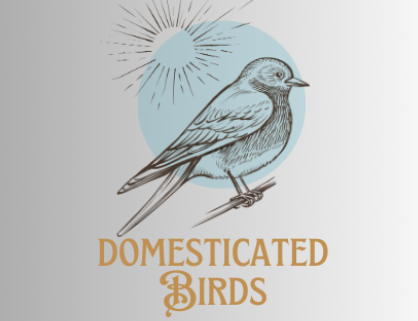
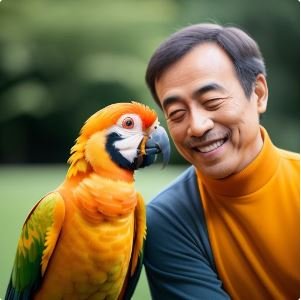
Nice response in return of this quer with firm rguments and telling the whole thing concerning
that.
my webpage; https://Sites.Google.com/View/gambling-Gamingindustry